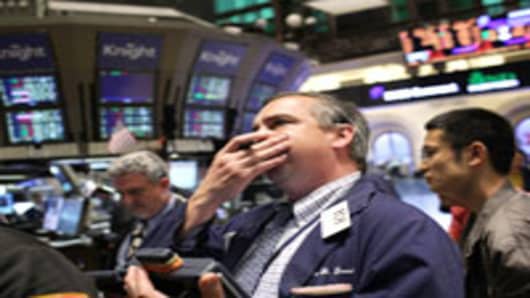A relentless stream of bad news has turned what could have been a short-term market dip into what now looks like a prolonged sell-off—with no bottom in sight.
While the Standard & Poor's downgrade of U.S. debtwas in itself a needle-moving event, it has served also to amplify the problems both domestically and elsewhere in the world.
Taking note, investors have engaged in a two-week selling spree, ditching stocks in favor of Treasuryseven though the S&P downgrade specifically warned about the stability of U.S. debt and the accompanying credit and rate risks.
"We have a ways to go, just because we keep dropping additional shoes," said Susan Fulton, founder and principal at FBB Capital Markets in Bethesda, Md. "The lowering of the rating gave everyone time to worry. Europe is still a mess. Our dilemma is as much Europe as the United States, but that doesn't make it any easier."
Doubts that politicians in Washington, and in European peripheral countries such as Italy, Greece and Spain, can navigate their way out of the crisis are of continuing concern.
"We have so many issues that it's hard to see how we're going to work our way out of them, as much as anything with the political issues," Fulton says. "We don't seem to be helping ourselves. Not only are we in trouble but we're trying to drown the man that's come out to save us."
Searching for a bottom is a natural reaction for the market when it enters correction mode, defined as a 10 percent pullback from the most recent high.
Just two sessions ago, it looked like the 500-plus-point drop in the Dow industrials indicated that capitulation was setting inand the market could be ready to move on. But the downgrade has given investors one more thing to worry about, meaning that talk of a bottom is probably premature.
"Everyone is trying to call a bottom now (which is never the hallmark of a panic low) and is what you would like to see to start dipping a few toes back into the market," David Rosenberg, economist and strategist at Gluskin Sheff in Toronto, said in his daily note. "The term 'buying opportunity' is posted in so many circles, and what is interesting is that you never ever hear the term 'selling opportunity' on Wall Street."
Nevertheless, Rosenberg said the market will find a bottom at some point and offers five signs that will tell when one has set in:
Technicals, such as retracement levels from recent high points; valuation, such as low forward price-to-earnings ratios; fund flows, showing behavior of institutional investors; sentiment, such as investor polls and the CBOE Volatility Index ; and fundamentals.
Yet he noted that each has its flaws and investors will need to watch downward earnings revisions and changes to economic forecasts to get a better handle on when a bottom has been put in.
"This is not a replay of mid-2010," Rosenberg cautioned in reference to a summertime dip that took the market down 17 percent, but preceded a rally that came after the Federal Reserve launched a second round of quantitative easing . "The global economy is slowing down much faster than was the case then and the problems surrounding sovereign government debt are far more acute."
As such, it's become a guessing game where the bottom might come.
If the market is pricing in a full-blown recession—two straight quarters of negative economic growth—then the bottom might not come until the S&P 500 hits 1020, another 12 percent drop from midday levels Monday, according to Mary Ann Bartels, technical research analyst at Bank of America Merrill Lynch.
Bartels said sentiment, particularly reflected through the American Association of Individual Investors survey, is far from indicating a bearish outlook sufficient enough to signal an end to selling.
"Given the intensity and magnitude of the decline, we think the market is beginning to price in a recession," Bartels said in a note. "Therefore it is becoming more challenging for the S&P to achieve our 2011 target of 1400. It would likely take additional Fed easing such as (a thrird round of easing) to support equities and to reach our target for the year."
Even from those who think the market does not need to fall that far, there is still a belief that there is a distance to travel yet before a turnaround can be hit.
"You're seeing the smart money trying to pick people off. But some of the other smart money is waiting to see if there are liquidations to see where you can get better prices," says Uri Landesman, president of Platinum Partners hedge fund in New York. "Stocks are cheap here...It's just a matter of where you step in."
Landesman sees the S&P unlikely to pass below 1100 for now after a period in which the market was able to withstand a barrage of bad news.
"Things are going to correct to the way they should be. Because it took a little longer just makes it more pronounced," he says. "There is going to be a point where stocks are a giveaway. People are going to step in and start buying. I would think it would certainly happen by 1100 if not before then."



